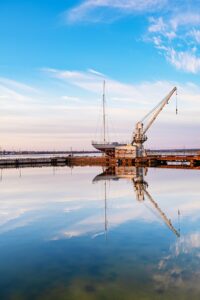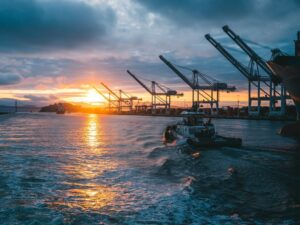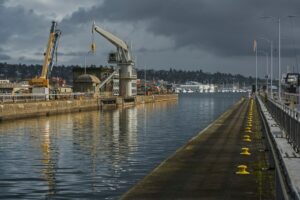
As the world’s demand for energy continues to grow, renewable energy sources are becoming increasingly vital for a sustainable future. Seafloor mining, an emerging and innovative practice, has the potential to contribute significantly to the renewable energy sector by providing the necessary resources for advanced technology development. In this article, we will explore the possibility of seafloor mining in the context of renewable energy, examining its benefits, challenges, and prospects.
Seafloor Mining:
Seafloor mining is extracting valuable minerals and metals from the ocean floor. Critical seafloor resources include polymetallic nodules, sulfides, and cobalt-rich ferromanganese crusts. These materials are indispensable for renewable energy technologies such as solar panels, wind turbines, and batteries for electric vehicles and energy storage systems. For instance, cobalt and lithium are essential components of lithium-ion batteries, while rare earth elements are crucial for permanent magnet generators used in wind turbines.

Potential Benefits of Seafloor Mining for Renewable Energy
- Abundant Resources: The seafloor holds vast quantities of untapped mineral resources crucial for developing and expanding renewable energy technologies. Exploiting these resources can help address the ever-growing demand for these critical materials and ensure the uninterrupted growth of renewable energy infrastructure.
- Reduced Environmental Impact: Seafloor mining has the potential to cause less environmental damage compared to land-based mining. As the process takes place underwater, there is no need for deforestation, soil erosion, or habitat destruction commonly associated with terrestrial mining operations.
- Diversification of Supply Chains: Seafloor mining can provide an alternative and diversified supply of critical minerals and metals, reducing the reliance on a few countries currently dominating the market. This diversification will increase the resilience and security of supply chains for renewable energy technologies.
Challenges in Seafloor Mining
- Environmental Concerns: One of the most significant concerns surrounding seafloor mining is the potential impact on deep-sea ecosystems. The extraction process can cause sediment plumes, noise pollution, and physical disturbance to the seabed, potentially affecting marine life and biodiversity.
- Regulatory Framework: The legal and regulatory frameworks governing seafloor mining are still in their infancy. The International Seabed Authority (ISA) is responsible for managing these resources. However, as seafloor mining is a relatively new field, the regulations continually evolve and can create uncertainty for investors and operators.
- Technological Hurdles: Seafloor mining requires advanced and specialized equipment to operate in deep-sea environments. Developing and deploying these technologies can be costly and challenging, particularly considering the harsh operating conditions and the need to minimize environmental impacts.
The Future of Seafloor Mining in Renewable Energy
The demand for critical minerals and metals will only increase as the renewable energy sector expands. Seafloor mining presents a unique opportunity to meet this demand while reducing the environmental impact of traditional mining methods. However, developing and implementing strict ecological regulations and investing in advanced technologies are essential to ensure the sustainable and responsible extraction of resources from the ocean floor.
Projects
- Solwara 1 Project (Papua New Guinea): Operated by Nautilus Minerals, the Solwara 1 Project aims to extract polymetallic sulfides from the seafloor in the Bismarck Sea. The project targets high-grade copper, gold, zinc, and silver deposits. However, the project faced financial challenges and environmental opposition, stalling its development.
- Clarion-Clipperton Zone (CCZ) Projects: The Clarion-Clipperton Zone, located in the Pacific Ocean between Hawaii and Mexico, is a vast area rich in polymetallic nodules containing manganese, nickel, copper, and cobalt. Several companies, including DeepGreen Metals (now known as The Metals Company), UK Seabed Resources (a subsidiary of Lockheed Martin), and Global Sea Mineral Resources (a subsidiary of DEME Group), have secured exploration licenses from the International Seabed Authority (ISA) to study the potential for mining in the region.
- NORI-D Project (Cook Islands): In partnership with Ocean Minerals LLC, the government is exploring the potential for extracting polymetallic nodules from the Cook Islands Exclusive Economic Zone. The NORI-D project focuses on assessing the area’s environmental impact and economic viability of seafloor mining.
- Central Indian Ocean Basin Project: The Indian government, through its National Institute of Ocean Technology (NIOT) and National Centre for Polar and Ocean Research (NCPOR), is exploring the Central Indian Ocean Basin for polymetallic nodules. The project aims to assess the region’s mineral resources and develop environmentally sustainable technologies for their extraction.
- Atlantis II Deep Project (Red Sea): Located in the Red Sea between Saudi Arabia and Sudan, the Atlantis II Deep is an area rich in polymetallic sulfides, containing deposits of copper, zinc, gold, and silver. The project is a joint venture between Diamond Fields International (DFI) and the Saudi Arabian Mining Company (Ma’aden). However, logistical, environmental, and geopolitical challenges could have delayed the project’s development.
